Temperature Citroen CX 1984 1.G User Guide
[x] Cancel search | Manufacturer: CITROEN, Model Year: 1984, Model line: CX, Model: Citroen CX 1984 1.GPages: 394
Page 96 of 394
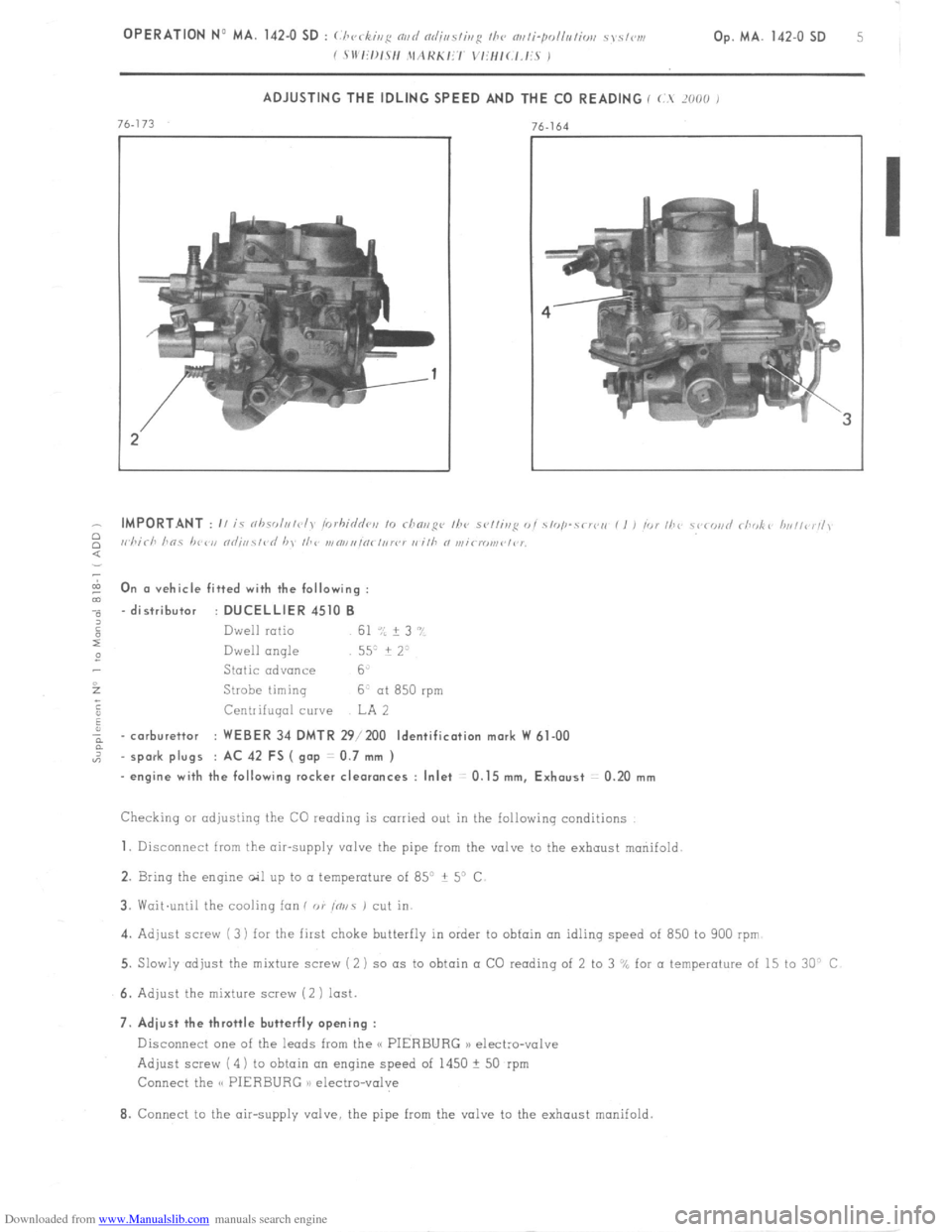
Downloaded from www.Manualslib.com manuals search engine OPERATION No MA. 142-O SD : (i ‘CC ,ii:: md nr/;,,sfinji //I<, “~,ti.pOlllLliol, .S,Sl~l,, k’
c s 11’1:/~12/1 ,\lAHKli’/ “,iH,(.,.li.S , Op. MA. 142-O SD 5
ADJUSTING THE IDLING SPEED AND THE CO READING ( (.. ‘01~0 I
- IMPORTANT : II i nhsr,l,,/<~l, irirhi<&,, ,o rhnri~q~, /he sv//ing o, .Y,<,,I-r< lo,, , I , ,o, //a~ ~i.
2 I, hirh hns /,<,,‘I, “
: 0
m n (I vehicle fitted with the following :
m
-.
“, - distributor : DUCELLIER 4510 B
6
Dwell ratio 61 ‘:: ? 3 ‘,
x
2 Dwell angle
557 i 2=
Static advance 6
i
Strobe liming 6. at 850 rpm
;
F Centrifugal curve LA 2
a
a - carburettor : WEBER 34 DMTR 29/200 Identification mark W 61-00
5
“2 - spark plugs : AC 42 FS ( g.ap : 0.7 mm )
- engine with the following rocker cleoronces : Inlet 0.15 mm, Exhaust : 0.20 mm
Checking or adjusting the CO reading is carried out in the following conditions
1. Disconnect from the air-supply valve the pipe from the valve to the exhaust mariifold.
2. Bring the engine ail up to a temperature of 85” ? 5” C.
3. Wait.until the cooling fan f or fnvs 1 cut in.
4. Adjust screw ( 3) for the first choke butterfly in order to obtain on idling speed of 850 to 900 rpm
5. Slowly adjust the mixture screw (2 ) so as to obtain a CO reading of 2 to 3 “A for a temperature of 15 to 30” C
6. Adjust the mixture screw (2 1 last.
7. Adiust the throttle butterfly opening :
Disconnect one of the leads from the S( PIERBURG n electro-valve
Adjust screw (4) to obtain on engine speed of 1450 + 50 rpm
Connect the S< PIERBURG n electro-valve
8. Connect to the air-supply valve, the pipe from the valve to the exhaust manifold.
Page 98 of 394
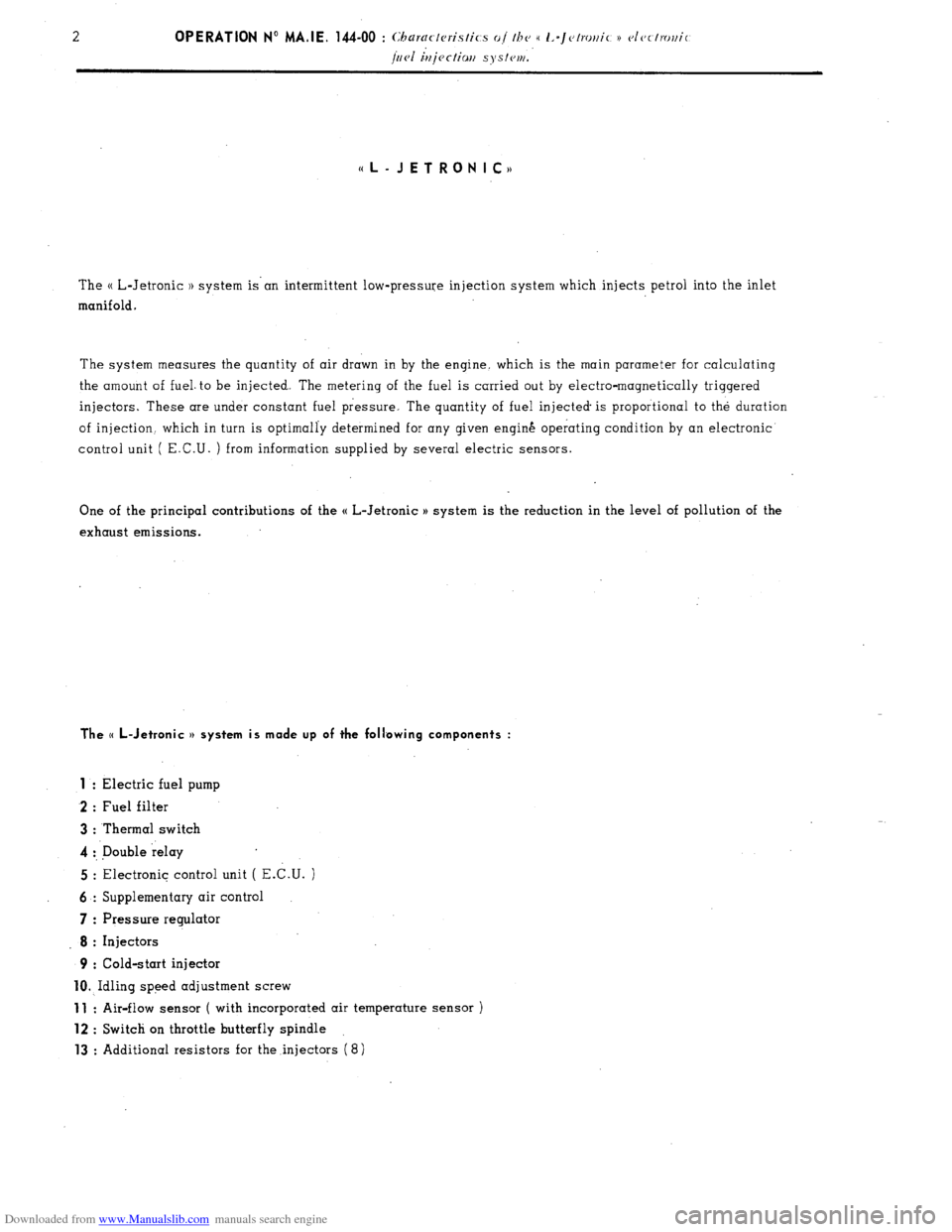
Downloaded from www.Manualslib.com manuals search engine 2
OPERATION No MA.IE. 144-00 : Chtiractcristics o/ the e 1,-Jc,tror,ic H clcctroltic
fire1 injc ctiwt systettt.
((L-JETRONIC,,
The H L-Jetronic 1) system is’an intermittent low-pressure injection system which injects petrol into the inlet
manifold.
The system measures the quantity of air drawn in by the engine. which is the main parameter for calculating
the amount of fuel. to be injected. The metering of the fuel is carried out by electro-magnetically triggered
injectors. These are under constant fuel pressure. The quantity of fuel injected is proportional to the duration
of injection. which in turn is optimally determined for any given engin& operating condition by an electronic
control unit ( E.C.U. ) from information supplied by several electric sensors.
One of the principal contributions of the H L-Jetronic H system is the reduction in the level of pollution of the
exhaust emissions.
The (( L-Jetronic v system is made up of the following components :
1
: Electric fuel pump
2 : Fuel filter
3 : Thermal switch
4 :, Double relay
5 : Electronic control unit ( E.C.U. )
6 : Supplementary air control
7 : Pressure regulator
8 : Injectors
9 : Cold-start injector
10. Idling speed adjustment screw
11 : Air-flow sensor ( with incorporated air temperature sensor )
12 : Switch on throttle butterfly spindle
13 : Additional resistors for the injectors (8)
Page 100 of 394
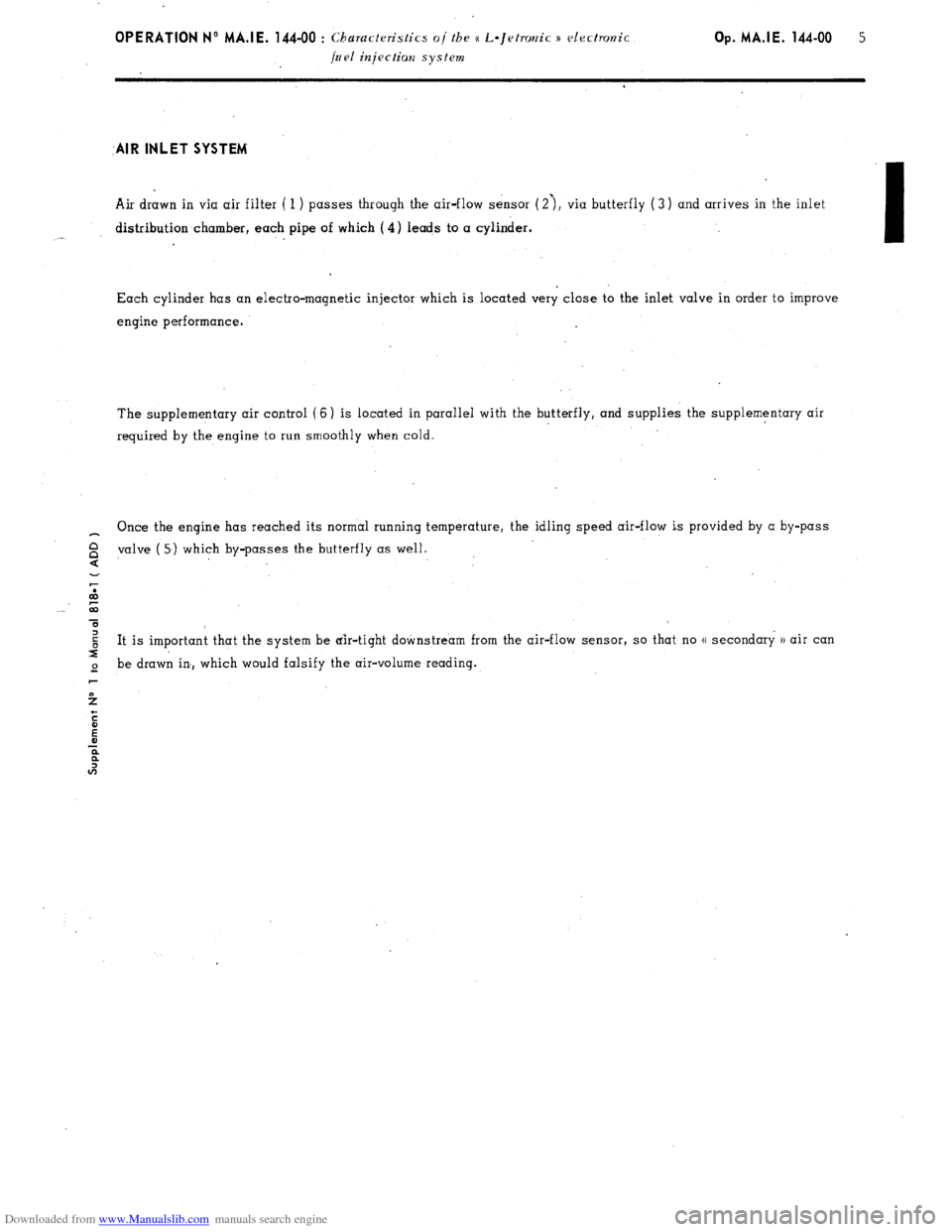
Downloaded from www.Manualslib.com manuals search engine OPERATION No MA.IE. 144-00 : Chu~acte~istics of the (( L-Jetronic n electronic
fuel injectiari system Op. MA.IE. 144-00 5
-AIR INLET SYSTEM’
Air drawn in via air filter ( 1 ) passes through the air-flow sensor (2’), via butterfly ( 3) and arrives in the inlet
distribution chamber, each pipe of which (4) leads to a cylinder.
-
‘I
Each cylinder has an electro-magnetic injector which is located very close to the inlet valve in order to improve
engine performance.
The supplementary air control (6) is located in parallel with the butterfly, and supplies the supplementary air
required by the engine to run smoothly when cold.
_ Once the engine has reached its normal running temperature, the idling speed air-flow is provided by a by-pass
valve
$ ( 5) which by-passes the butterfly as well.
.
2
co
T
$ It is important that the system be air-tight downstream from the air-flow sensor, so that no (( secondary )) air can
I
2 be drawn in, which would falsify the air-volume reading.
Page 104 of 394

Downloaded from www.Manualslib.com manuals search engine OPEdATlON N- MA.IE. 144-00 : C1 3aractcJristics o/ the e L-Jetro~ic n elcctrorlir Op. MA.IE. 144-00 9
fuel injectian systwn. E.C.U; ( ELECTRONIC CONTROL UNIT )
Apart from three integrated circuits ( I.C. ) forming the main part of the E.C.U., there are in addition only a few
semi-conducting components condensers, calibrating resistors and filters so as to avoid.any interference.
I
The function of the E.C.U. is ,to supply an impulse to the injectors, and to control their opening for a precisely
defined amount of time. The E.C.U. to this effect uses the information provided by all the engine sensors which
translate the operating conditions of the engine into electric impulses.
All the injectors are connected in parallel, and inject fuel simultaneously twice for each rotation of the camshaft
( therefore,twice for each engine cycle ), injecting half the quantity of fuel required each time With this system
it is not necessary for the camshaft angle to coincide with the beginning of injection point, which eliminates the
need for a generating switch incorporated in the distributor.
The injection impulse control is ensured by the distributor impulses. The distributor produces four impulses for
every operational cycle. Since injection only occurs twice in every cycle, the E.C.U. must divide the frequency
by 2.
The impulses coming from the distriLti, are transformated into square waves by the waveform shaper. Since
injection only occurs twice for each camshaft rotation, whereas the distributor provides 4 impulses in the same
amount of time, the frequency of the impulses must be divided by 2 in the frequency divider.
These signals are used to charge a condenser. The condenser discharge determines the beginning of injection
point; the position of the air-flow sensor flap ( which determines the quantity of air drawn in ) being the main
parameter for calculating the duration of injection.
At the multiplying stage of the E.C.U., various correction values ( full load and idling speed via throttle butterfly
spindle switch, engine temperature via the water temperature sensor, air temperature via the air-temperature sensor
located in the air-flow sensor ) are combined with the signals from the air-flow sensor and the injt,ztion frequency
in order to determine the injection duration which is transmitted to the injectors by way of impulses.
The time it takes for the injector needle to open and close depends on the battery voltage.
As the supply voltage increases, the injection duration increases.
The fact that the quantity of fuel injected depends
on the voltage is cancelled out by the fact that the injection duration is inversely proportional to the voltaqq,in the
E.C.U.
The final impulse determines the time during which the injectors are connected to earth ( injection duration ‘supplied
by the output stage ).
Page 105 of 394

Downloaded from www.Manualslib.com manuals search engine 10 OPERATION No MA.IE. 144-00 : Characteristics o/ the K L=Jetronic )) electronic
/uel iujectian system. AIR-FLOW SENSOR ( 1) :
The role of the air-flow sensor is to supply the E.C.U. with a signal proportional in voltage to the quantity of air
drawn in.
With the engine running, the sensor flap is maintained at an angular position determined by the intensity of the-air- ,
flow, against the resistive action of a spiral spring. The resistance to deflection of the sensor flap, produced by the
spiral spring, is calculated so as to compensate for any mechanical friction ( bearings, bushes ) and to limit the
pressure drop at the flap.
The movement of the sensor flap is damped by a blade rigidly attached to it. This damping blade rotates inside a
housing in which it is a close fit. The operating clearance determines the degree of damping. The use of a damping
blade cancels the effects on the angular position of the sensor flap of pressure variation’s in the inlet collector.
A potentiometer, actuated by the sensor flap spindle, transforms movement of the sensor flap into an electrical circuit which is transtiitted to the E.C.U.. The voltage of the electrical ‘current is inversely proportional to the
amount of air drawn-in.
In order to cancel the effects of any combustion taking place in the inlet manifold, a one-way valve is incorporated in the sensor flap.
Thanks to a by-pass channel, a small quantity of the air drawn ,in by-passes the sensor flap. This offers the possibility
of determining the air/lfuel mixture at idling speed by’varying the diameter of the by-pass channel, since the air going
through the by-pass is not measured. The switch for the pump ( engine running ) and the air temperature sensor are
located in the air-flow sensor.
Page 108 of 394
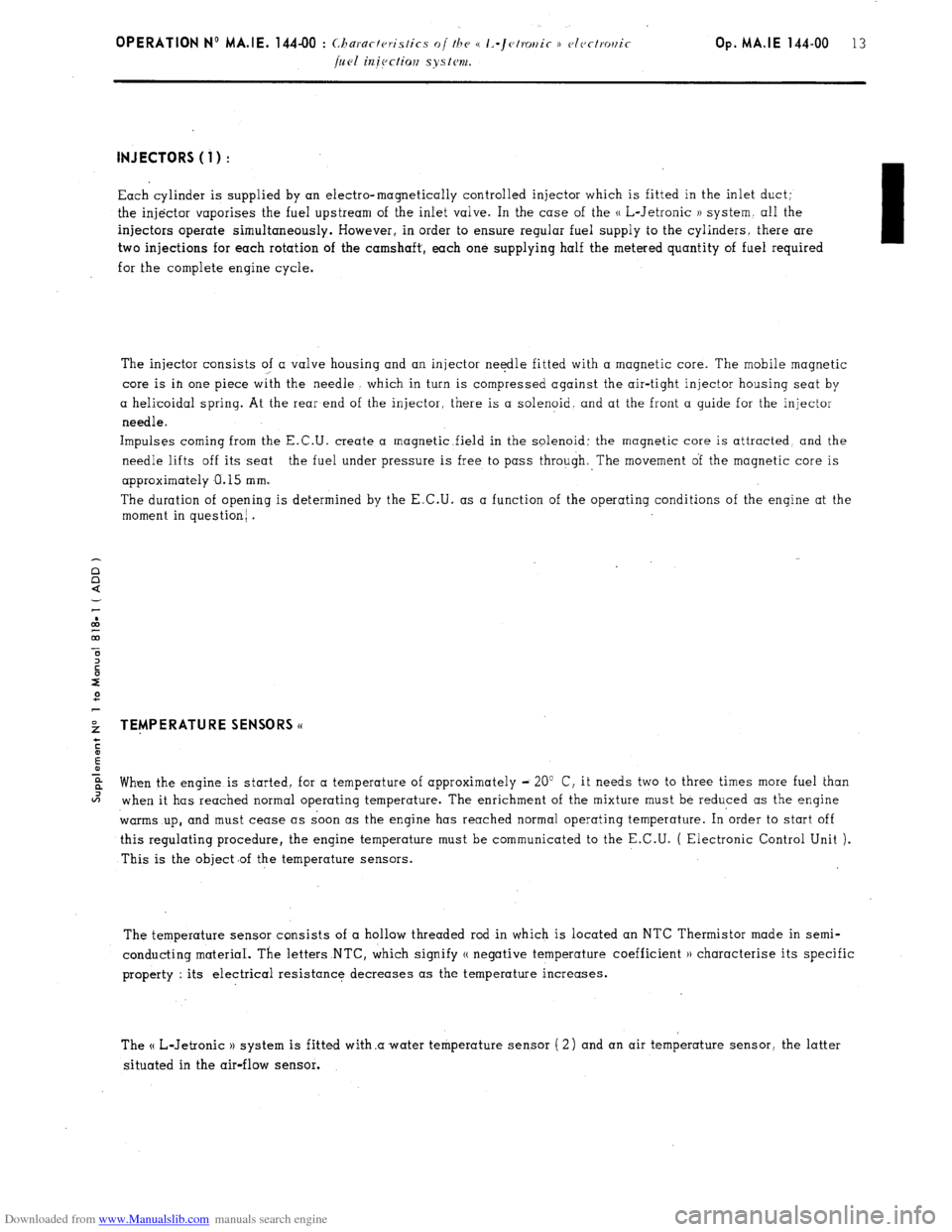
Downloaded from www.Manualslib.com manuals search engine INJECTORS ( i ) :
Each cylinder is supplied by an electro-magnetically controlled injector which is fitted in the inlet duct;
the injector vaporises the fuel upstream of the inlet valve. In the case of the (( L-Jetronic )) system. all the
injectors operate simultaneously. However, in order to ensure regular fuel supply to the cylinders, there are
two injections for each rotation of the camshaft, each one supplying half the metered quantity of fuel required I
for the complete engine cycle.
The injector consists of a valve housing and an injector needle fitted with a magnetic core. The mobile magnetic
/
core is in one piece with the needle which in turn is compressed against the air-tight injector housing seat by
a helicoidal spring. At the rear end of the injector, there is a solenoid. and at the front a guide for the injector
needle.
Impulses coming from the E.C.U. create a magnetic.field in the solenoid; the magnetic core is attracted, and the
needle lifts off its seat the fuel under pressure is free to pass through, The movement of the magnetic core is
approximately 0.15 mm.
The duration of opening is determined by the E.C.U. as a function of the operating conditions of the engine at the
moment in question{. TEMPERATURE SENSORS t(
When the engine is started, for a temperature of approximately - 20” C, it needs two to three times more fuel than
when it has reached normal operating temperature. The enrichment of the mixture must be reduced as the engine
warms up, and must cease as soon as the engine has reached normal operating temperature. In’order to start off
this regulating procedure, the engine temperature must be communicated to the E.C.U. ( Electronic Control Unit ).
This is the object .of the temperature sensors.
The temperature sensor consists of a hollow threaded rod in which is located an NTC Thermistor made in semi-
conducting material. The letters .NTC, which signify (( negative temperature coefficient )) characterise its specific
property : its electrical resistance decreases as the temperature increases.
The (( L-Jetronic 1) system is fitted with.a water temperature sensor ( 2) and an air temperature sensor, the latter
situated in the air-flow sensor.
Page 109 of 394
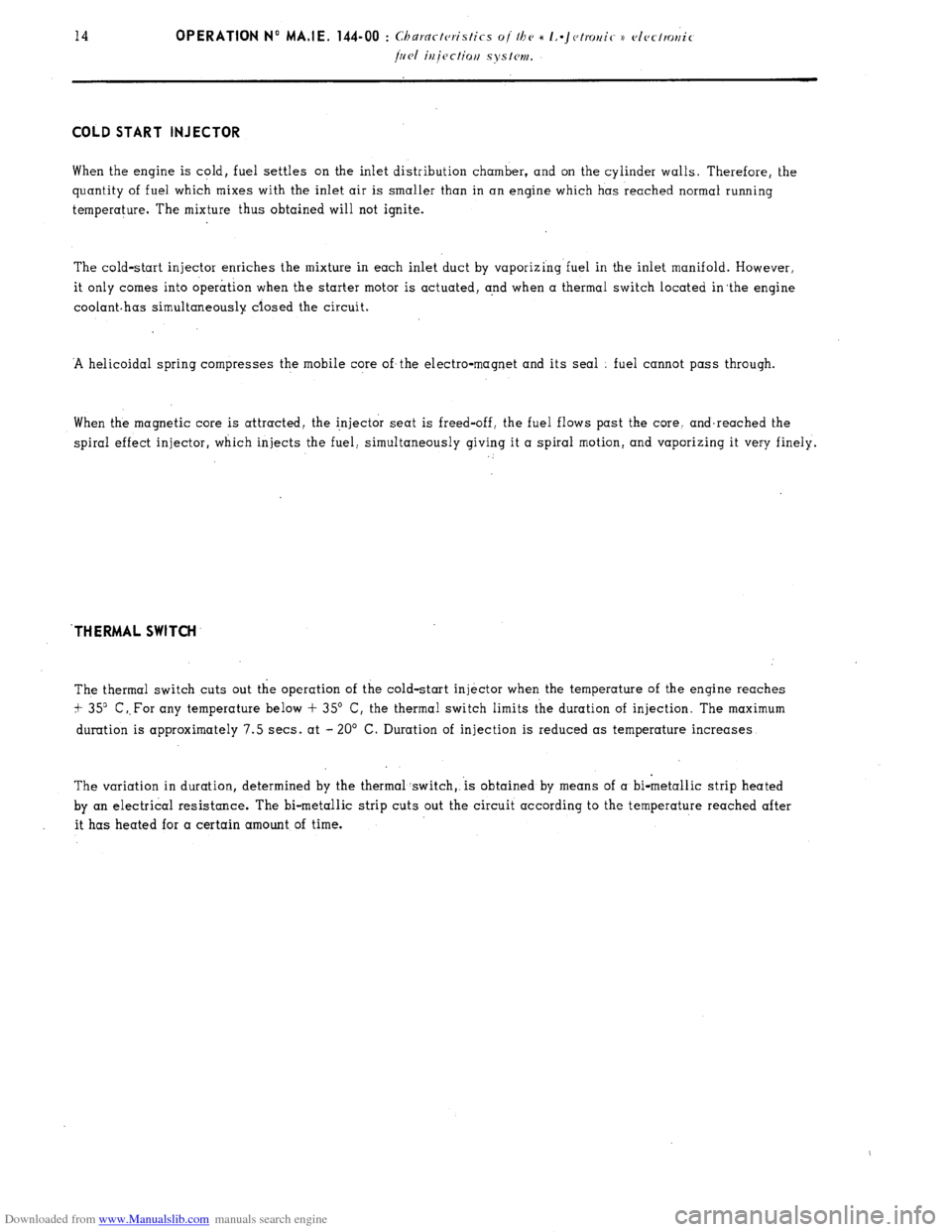
Downloaded from www.Manualslib.com manuals search engine COLD START INJECTOR
When the engine is cold, fuel settles on the inlet distribution chamber, and on the cylinder walls. Therefore, the
quantity of fuel which mixes with the inlet air is smaller than in an engine which has reached normal running
temperature. The mixture thus obtained will not ignite.
The cold-start injector enriches the mixture in each inlet duct by vaporizing fuel in the inlet manifold. However,
it only comes into operation when the starter motor is actuated, and when a thermal switch located inthe engine
coolanthas simultaneously closed the circuit.
‘A helicoidal spring compresses the mobile core of,the electro-magnet and its seal fuel cannot pass through.
When the magnetic core is attracted, the injector seat is freed-off, the fuel flows past the core. and.reached the
spiral effect injector, which injects the fuel, simultaneously giving it a spiral motion, and vaporizing it very finely. ‘THERMAL SWITCH
The thermal switch cuts out the operation of the cold-start injector when the temperature of the engine reaches
ir 35” C,,For any temperature below t 35’ C, the thermal switch limits the duration of injection. The maximum
duration is approximately 7.5 sets. at - 20’ C. Duration of injection is reduced as temperature increases
The variation in duration, determined by the thermal switch,.is obtained by means of a bi-metallic strip heated
by an electrical resistance. The bi-metallic strip cuts out the circuit according to the temperature reached after
it has heated for a certain amount of time.
Page 112 of 394
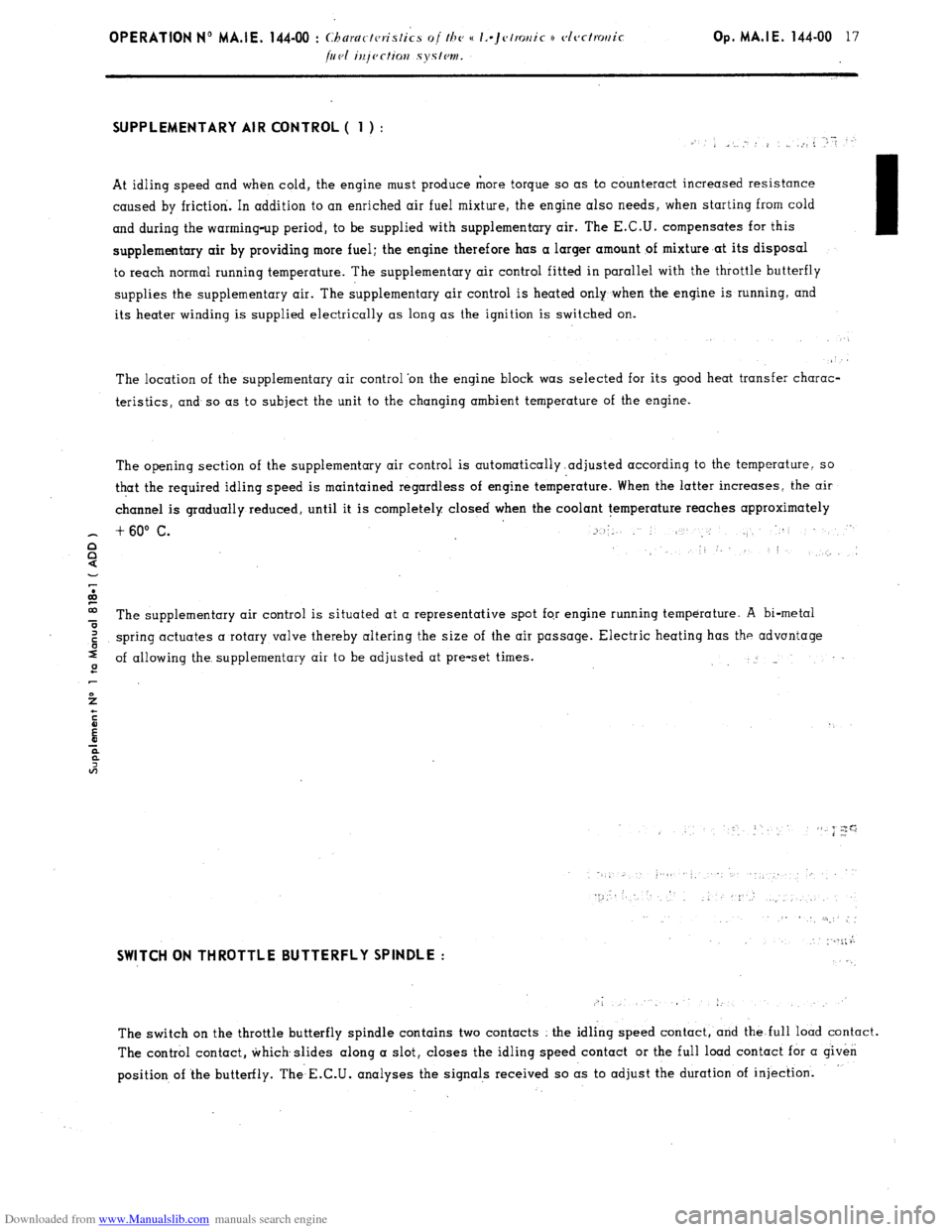
Downloaded from www.Manualslib.com manuals search engine OPERATION No MA.IE. 144-00 : Chnract~~ristics o/ the H I,-jctrortic P dectrnr~ir
/i/c,1 iujcctim splcm. Op. MA.IE. 144-00 17
SUPPLEMENTARY AIR CONTROL ( 1 ) :
I’ / -...’ , _, ._,, ! .’ ! . .
At idling speed and when cold, the engine must produce more torque so as to counteract increased resistance
caused by friction. In addition to an enriched air fuel mixture, the engine also needs, when starting from cold
and during the warming-up period, to be supplied with supplementary air. The E.C.U. compensates for this
supplementary air by providing more fuel; the engine therefore has a larger amount of mixture at its disposal
to reach normal running temperature. The supplementary air control fitted in parallel with the throttle butterfly
supplies the supplementary air. The supplementary air control is heated only when the engine is running, and
its heater winding is supplied electrically as long as the ignition is switched on.
The location of the supplementary air control ‘on the engine block was selected for its good heat transfer charac-
teristics, and so as to subject the unit to the changing ambient temperature of the engine.
The opening section of the supplementary air control is automatically .adjusted according to the temperature, so
that the required idling speed is maintained regardless of engine temperature. When the latter increases, the air
channel is gradually reduced, until it is completely closed when the coolant temperature reaches approximately
+ 60” C. ->.:.. .-. : --.
,
The supplementary air control is situated at a representative spot fo.r engine running temperature. A bi-metal
spring actuates a rotary valve thereby altering the size of the air passage. Electric heating has the advantage
of allowing the. supplementary air to be adjusted at pre-set times. SWITCH ON THROTTLE BUTTERFLY SPINDLE :
,‘1 3 >_
The switch on the throttle butterfly spindle contains two contacts the idling speed contact, and the.full load contact.
The control contact, which.slides along a slot, closes the idling speed contact or the full load contact for a given
position of ‘the butterfly. The’ E.C.U. analyses the signals received so as to adjust the duration of injection.
Page 131 of 394
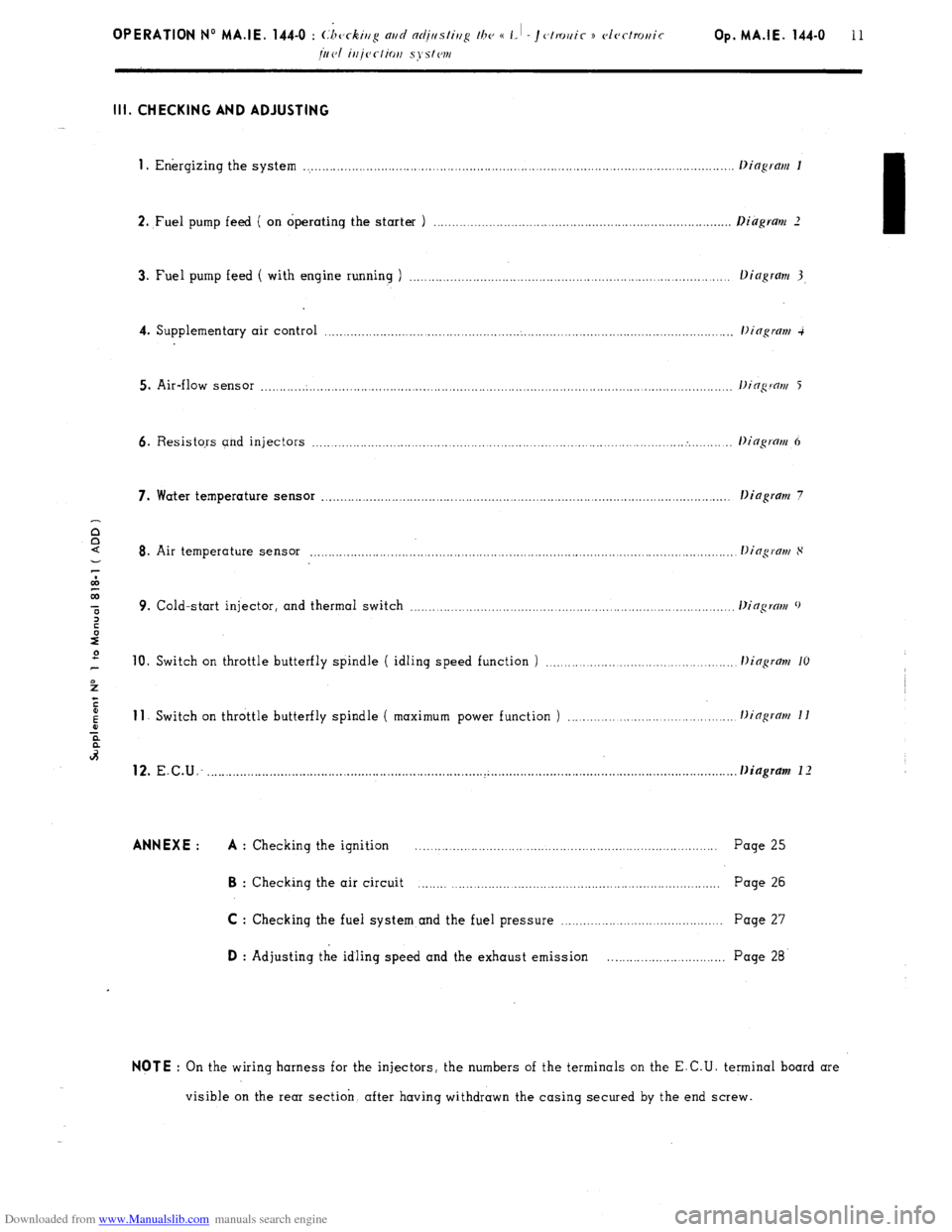
Downloaded from www.Manualslib.com manuals search engine Ill. CHECKING AND ADJUSTING
1
. Energizing the system ..................................................................................................................
2. ,Fuel pump feed ( on operating the starter ) .............................................................................
3. Fuel pump feed ( with engine running ) ...................................................................................
4. Supplementary air control ...........................................................................................................
5. Air-flow sensor ............................................................................................................................
6. Resistors and injectors ................................................................................................... . ........
7. Water temperature sensor ............................................................................................................ .
Dingram 7
8. Air temperature sensor ...............................................................................................................
9. Cold-start injector, and thermal switch ...................................................................................
10. Switch on throttle butterfly spindle ( idling speed function ) ............................................ 11
Switch on throttle butterfly spindle ( maximum power function ) ...................................... 12.
E.C.U: ......................................................................... ..~ ............................................................... . . Diagram 1 I ANNEXE : A
: Checking the ignition .................................................................................. Page 25 B
: Checking the air circuit ................................................................................ Page 26
C : Checking the fuel system and the fuel pressure ........................................... Page 27 D
: Adjusting the idling speed and the exhaust emission .............................. Page 28 NOTE
: On the wiring harness for the injectors, the numbers of the terminals on the E.C.U. terminal board are
visible on the rear section. after having withdrawn the casing secured by the end screw.
Page 135 of 394
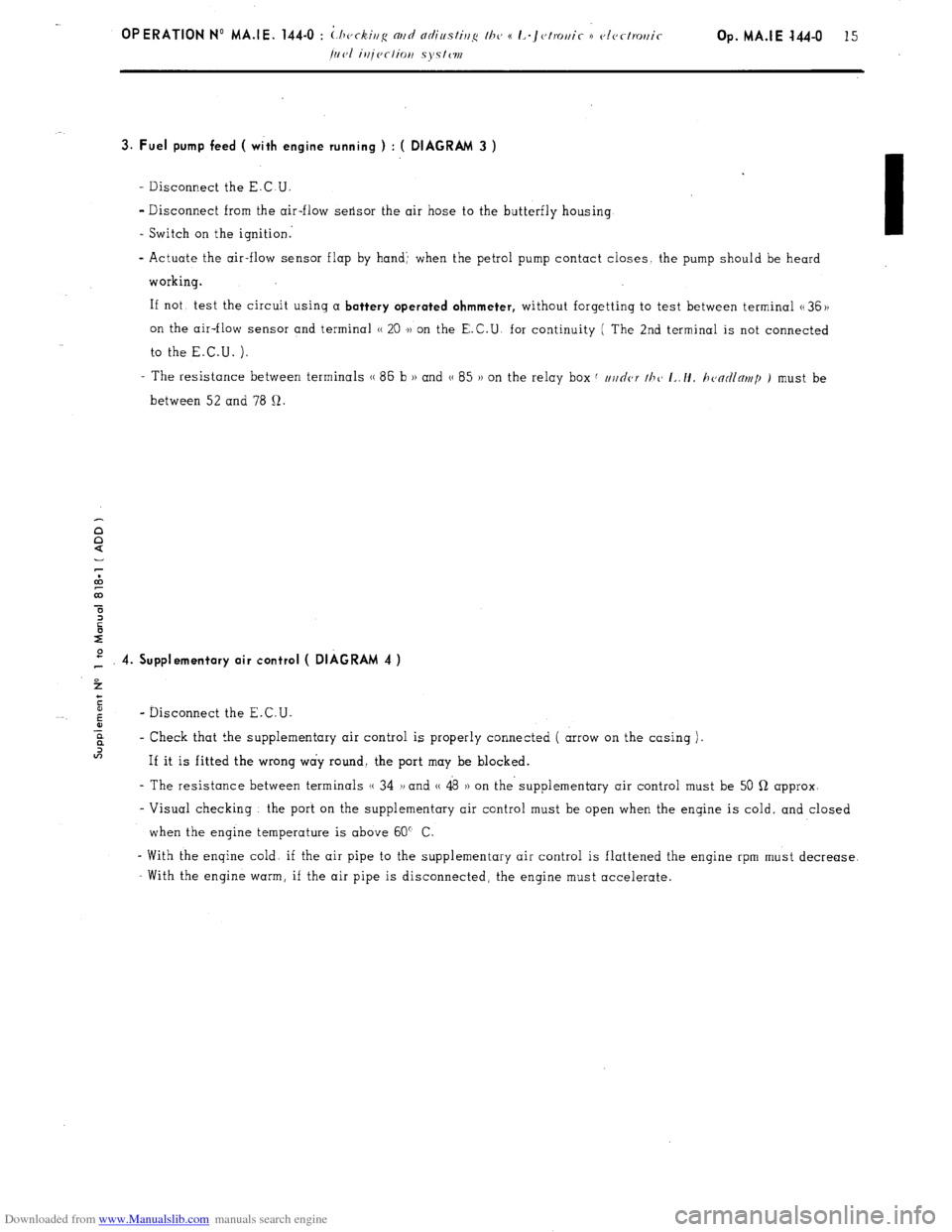
Downloaded from www.Manualslib.com manuals search engine Op. MA.IE 444-O 15
3. Fuel pump feed ( with engine running ) : ( DIAGRAM 3 )
- Disconnect the E.C.U.
- Disconnect from the air-flow sensor the air hose to the butterfly housing
- Switch on the ignition:
- Actuate the air-flow sensor flap by hand’ when the petrol pump contact closes the pump should be heard
working.
If not, test the circuit using a
battery operated ohmmeter, without forgetting to test between terminal G 36 ))
on the air-flow sensor and terminal H 20 .)) on the E.C.U. for continuity ( The 2nd terminal is not connected
to the E.C.U. ).
- The resistance between terminals (( 86 b H and G 85 )) on the relay box f //j/nor thc~ I~./I. h<~ntllnr~tp ) must be
between 52 and 78 12.
P 4. Supplementary air control ( DIAGRAM 4 )
4
c
5
6
- Disconnect the E.C.U.
-E
? - Check that the supplementary air control is properly connected ( arrow on the casing )~
In
If it is fitted the wrong way round. the port may be blocked.
- The resistance between terminals (( 34 1, and (( 48 )) on the- supplementary air control must be 50 Q approx-
- Visual checking the port on the supplementary air control must be open when the engine is cold, and closed
when the engine temperature is above 60” C
- With the engine cold. if the air pipe to the supplementary air control is flattened the engine rpm must decrease.
With the engine warm, if the air pipe is disconnected, the engine must accelerate.